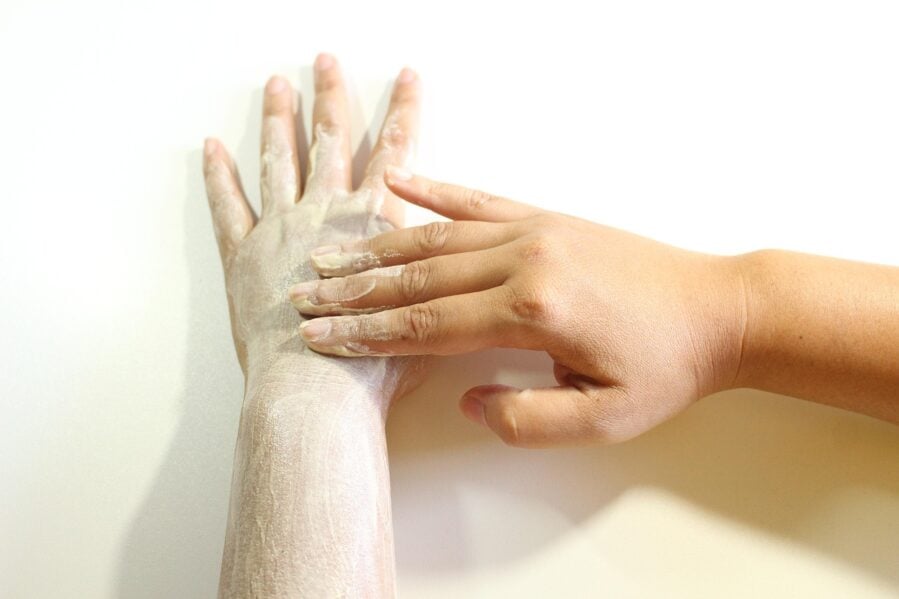The simple act of applying lotion or perfume does more than moisturize skin or add pleasant scent—it creates a protective barrier against a potentially harmful “oxidation field” that surrounds human bodies, according to new research published Wednesday in Science Advances.
Scientists from the University of California, Irvine, Max Planck Institute for Chemistry, and Pennsylvania State University discovered that everyday personal care products significantly reduce the concentration of highly reactive hydroxyl radicals that form around our bodies when skin oils interact with indoor ozone.
This previously unknown benefit of lotions and fragrances adds a surprising twist to our understanding of indoor air chemistry and how the products we apply to our bodies might affect our health beyond skin deep.
How Your Body Creates Its Own Chemical Cloud
The human oxidation field forms when ozone—a common indoor air pollutant—reacts with natural oils on our skin, particularly squalene. This reaction generates hydroxyl radicals, which are extremely reactive molecules comparable to outdoor pollution levels in some locations. These radicals can transform many compounds in our immediate surroundings into new chemicals.
How powerful is this effect? At typical indoor ozone levels of about 40 parts per billion in a ventilated room, one young adult generates an oxidation field with hydroxyl radical concentrations of about 200,000 molecules per cubic centimeter—comparable to levels found outdoors in polluted environments.
But what happens when we apply personal care products? That’s what researchers wanted to know.
Lotions and Fragrances Create a Chemical Shield
The research team conducted experiments with volunteers in a controlled chamber environment, measuring chemical reactions with and without personal care products applied. They found two distinct mechanisms at work:
- Body lotions create a physical barrier between ozone and skin oils, reducing the generation of hydroxyl radicals by diluting skin oil constituents to about 7% of their original concentrations
- The ethanol solvent in fragrances acts as a large hydroxyl radical “sink,” absorbing these reactive molecules before they can interact with other compounds
- Preservatives in lotions, such as phenoxyethanol, further contribute to suppressing the human oxidation field
- Even pure essential oils showed some effect, though much less dramatic than alcohol-based fragrances
The Science Behind the Shield
To understand how these products affect our personal oxidation fields, researchers developed sophisticated computer models that tracked the movement and concentration of different chemicals around human bodies in indoor environments.
“Our team took a unique approach to simulate concentrations of chemical compounds near humans in the indoor environment,” said Manabu Shiraiwa, UC Irvine professor of chemistry who co-led the study. “We developed a state-of-the-art chemical model that can simulate reactions of ozone with human skin and clothing that can lead to the formation of [hydroxyl radicals] and semi-volatile organic compounds.”
The models revealed that fragrance application can cause hydroxyl radical concentrations to drop by up to 86%, while body lotions can reduce them by 30-140% depending on the specific product and application amount.
Why Does This Matter for Health?
The implications extend beyond interesting chemistry. The study suggests these oxidation fields may influence the chemical composition of air in our breathing zones and potentially impact what compounds we’re exposed to in indoor environments.
“If we buy a sofa from major furniture company, it’s tested for harmful emissions before being put on sale. However, when we sit on the sofa, we naturally transform some of these emissions because of the oxidation field we generate,” said lead author Jonathan Williams, who heads the study of organic reactive species at the Max Planck Institute for Chemistry. “This can create many additional compounds in our breathing zone whose properties are not well known or studied. Interestingly, body lotion and perfume both seem to dampen down this effect.”
These findings are particularly significant considering people spend up to 90% of their time indoors, where they’re exposed to a complex cocktail of chemicals from furnishings, cleaning products, cooking, and now, their own bodies.
A Double-Edged Sword?
While reducing the oxidation field might seem entirely beneficial, the researchers point out that personal care products also introduce their own chemicals into the environment. The study notes that personal care products represent a massive $646.2 billion global industry as of 2024, with widespread consumption affecting both indoor and outdoor air quality.
The researchers suggest that in some cases, the chemical transformations resulting from increased hydroxyl radical levels might yield products with reduced toxicities compared to their precursors. However, the net consequence of increased hydroxyl levels appears to be less healthy indoor environments.
Looking Forward
The work was conducted as part of the Indoor Chemical Human Emissions and Reactivity project, bringing together international collaborators with computer modeling provided by the Modelling Consortium for Chemistry of Indoor Environments at UC Irvine. Both efforts received funding from the Alfred P. Sloan Foundation.
As researchers continue to unravel the complex chemistry of indoor environments, this study offers a fascinating glimpse into how the products we use daily might be silently altering the air quality in our immediate surroundings in previously unrecognized ways.
What other aspects of our daily routines might be invisibly altering our chemical exposures? That’s a question future research will need to address.
If our reporting has informed or inspired you, please consider making a donation. Every contribution, no matter the size, empowers us to continue delivering accurate, engaging, and trustworthy science and medical news. Independent journalism requires time, effort, and resources—your support ensures we can keep uncovering the stories that matter most to you.
Join us in making knowledge accessible and impactful. Thank you for standing with us!

